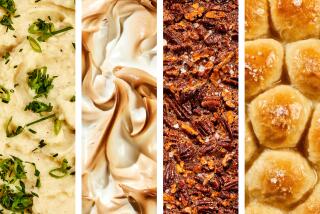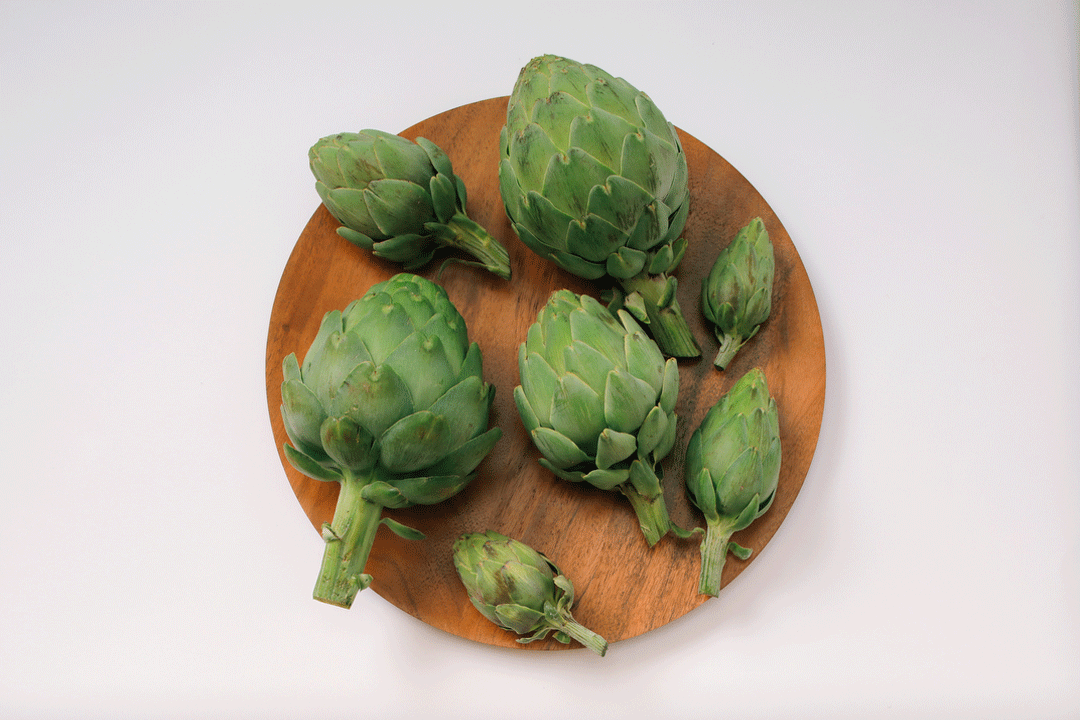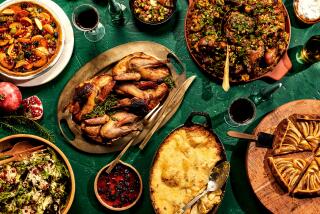A Separate Piece
- Share via
Like so many things about Thanksgiving dinner, stuffing is usually taken for granted, reduced by ritual to the role of a culinary obligation. It’s kind of like the cousin who is always there but never says anything more than “White meat, thanks,” “Please pass the gravy” or “Sure is a shame about Aunt Martha.”
Year in, year out, you’re so used to both of them being there that you never notice them.
But what do you suppose would happen if that cousin showed up this year in a Prada suit (gray, of course: this year’s black), saying things like “Have you read the new Anne Tyler?” or “The last time I ate at French Laundry, I had . . . “?
Thanksgiving might seem like a whole new holiday.
Finding a new cousin is difficult and renting one on such short notice is probably impractical. But stuffing . . . stuffing is one thing you can do something about.
The potential is unlimited. Stuffings run the gamut from white bread and sage to the Gaudiesque turducken, a turkey stuffed with a duck that’s been stuffed with a chicken (guess they couldn’t find any quail).
It’s best to think small, though, at least at first. This is, after all, Thanksgiving and not the time to unveil your latest whim. You wouldn’t want to give your family whiplash with your miso-flavored tropical fruit stuffing.
Instead, begin with familiar flavors, things you know people like. Having lived a good part of my life in the South, I find that things like smoked sausage and mustard greens seem like second nature (strangely, though, I’ve never really gotten used to corn bread stuffing).
Building a stuffing follows certain steps. First, you need a flavoring base. This is like the mirepoix you start a soup or sauce with. Chopped vegetables are cooked over moderate heat in a little bit of fat until they shine (chefs call this “sweating” a vegetable).
To this, you can add any other “major” flavorings, if they take pre-cooking. Otherwise, add them after you’ve folded the flavoring base into the dried bread cubes. Work gently, you want the bread to stay as intact as possible--cubes, not crumbs.
You’ll need some eggs to bind the mixture, to give it body. How many you use will depend on how moist the other ingredients you’ve added are. For a pound of bread crumbs, two eggs probably would be the minimum and four probably would be the maximum. Fold these in as well.
Now we come to the great divide of stuffings. Will yours be cooked inside the turkey or outside? There’s no getting around it, stuffing tastes better if cooked inside the turkey, where it soaks up fat and juices rendered during the cooking process.
On the other hand, because of the insulating quality of all that meat, getting your stuffing to a safe temperature (remember, it contains eggs) takes quite a bit of time. And it’s tricky to do that without overcooking the bird.
If you want to cook the stuffing separately, you’ll have to find some way to make up for the lost moisture. That’s pretty simple: turkey stock is best, followed by water and then chicken stock (unless it’s homemade, in which case it’s the second choice).
How much liquid to use takes some judgment. Again, the moistness of the flavorings come into play. But so do factors like what kind of pan you use to cook the stuffing and how long you plan to hold it after it’s done.
A cast-iron or heavy stainless steel casserole holds moisture pretty well, so you can use about 1 1/2 cups for every pound of bread, given an average moistness of flavorings. For a thin metal casserole, you’ll probably have to go to two cups to keep the stuffing from scorching on the bottom. If you’re cooking in earthenware, aim halfway between the two. Earthenware conducts heat evenly, but it also absorbs a lot of moisture at the start.
Also, remember that moisture continues to evaporate after the stuffing is removed from the oven. If you’re not going to serve it right away, add a little more liquid at the start.
The other trick to keeping stuffing moist is making sure the cooking vessel is tightly sealed. Not only do you need a good-fitting lid, you need to give the stuffing an aluminum foil blanket. Press it down flat on top of the stuffing and make sure it extends to the edges of the casserole. This keeps the moisture within the stuffing and doesn’t let it evaporate into the airspace between the food and the lid.
Starting the dish in a cold oven helps to keep it moist by heating the stuffing more evenly. Putting it in a hot oven dries out the bottom and sides of the dish before the inside is done. If you want the top to be brown and crusty, remove the lid and aluminum foil after the center has reached the correct temperature and bake it until it’s right.
It may sound complicated, but it’s not really. And when you’re done, you’ll have a moist stuffing that tastes almost as good as if you’d baked it in the turkey.
Your Thanksgiving holidays will be completely changed. Your life will be improved. Everyone will live happily ever after.
Well, not really. After all, stuffing is a lot easier to fix than family.
*
Sausage and Greens Dressing
Total Preparation Time: 1 hour * Active Work Time: 30 minutes
2 tablespoons oil (preferably bacon grease)
1 onion, coarsely chopped
2 stalks celery, sliced 1/4-inch thick
1 bell pepper, diced
1 pound smoked sausage, sliced 1/2-inch thick
2 bay leaves
3/4 pound mustard greens, chopped
1 pound unseasoned dried bread cubes
3 eggs
1 1/2 cups water
2 teaspoons salt
Black pepper
Heat oil in large skillet or baking dish over medium-high heat. Add onion and celery and cook until celery softens, about 5 minutes.
Add bell pepper and cook until pepper softens, about 5 minutes.
Add smoked sausage and bay leaves and cook 5 minutes, stirring frequently.
Add mustard greens and cook until barely wilted, about 5 minutes.
Remove pan from heat and add bread cubes, eggs and water and stir gently to combine thoroughly. Add salt and pepper to taste and stir again.
If using skillet, transfer contents to large, covered baking dish. Press aluminum foil closely over surface of stuffing, pressing to edges to seal. Cover and put in cold oven. Turn oven on to 350 degrees and bake to internal temperature of 155 degrees, about 30 minutes. Remove from oven, but don’t remove aluminum foil until ready to serve.
10 to 12 servings. Each of 12 servings: 169 calories; 732 mg sodium; 74 mg cholesterol; 13 grams fat; 7 grams carbohydrates; 7 grams protein; 0.45 gram fiber.
*
Place mat from HomeChef, Pasadena. Cucina fresca baking dish from Jordano’s, Santa Barbara.
More to Read
Eat your way across L.A.
Get our weekly Tasting Notes newsletter for reviews, news and more.
You may occasionally receive promotional content from the Los Angeles Times.











